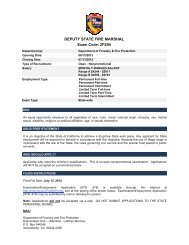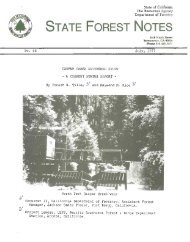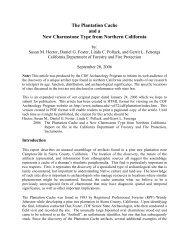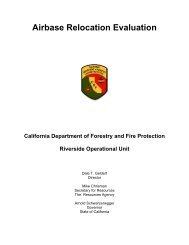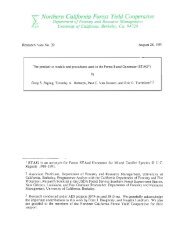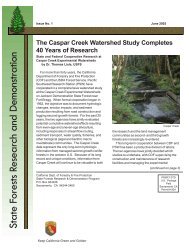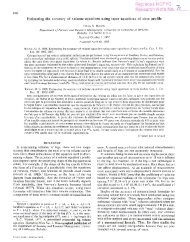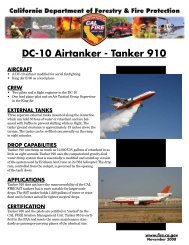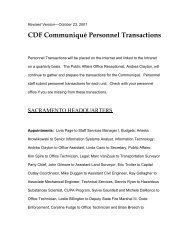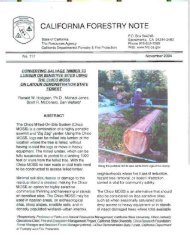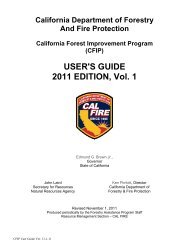A test of variable plot cruising in mixed stands on ... - Demoforests.net
A test of variable plot cruising in mixed stands on ... - Demoforests.net
A test of variable plot cruising in mixed stands on ... - Demoforests.net
You also want an ePaper? Increase the reach of your titles
YUMPU automatically turns print PDFs into web optimized ePapers that Google loves.
CALIFORNIA DIVISION OF FORESTRY<br />
DEPARTMENTOF NATURAL RESOURCES<br />
1111TE1f1RESTNflTES<br />
Office <str<strong>on</strong>g>of</str<strong>on</strong>g> the State Forester<br />
Sacramento 14, California<br />
Number 5 January, 1961<br />
A TEST OF VARIABLE PLOT CRUISING IN MIXED STANDS<br />
ON LATOUR STATE FOREST<br />
Paul Cox 1/<br />
Tests <str<strong>on</strong>g>of</str<strong>on</strong>g> <str<strong>on</strong>g>variable</str<strong>on</strong>g> <str<strong>on</strong>g>plot</str<strong>on</strong>g> <str<strong>on</strong>g>cruis<str<strong>on</strong>g>in</str<strong>on</strong>g>g</str<strong>on</strong>g> <str<strong>on</strong>g>in</str<strong>on</strong>g> which prisms were used were c<strong>on</strong>ducted<br />
<str<strong>on</strong>g>in</str<strong>on</strong>g> 1957 <strong>on</strong> the Latour State Forest, adm<str<strong>on</strong>g>in</str<strong>on</strong>g>istered by the California Divisi<strong>on</strong> <str<strong>on</strong>g>of</str<strong>on</strong>g><br />
Forestry. This property c<strong>on</strong>sists <str<strong>on</strong>g>of</str<strong>on</strong>g> about 9,000 acres located <str<strong>on</strong>g>in</str<strong>on</strong>g> eastern Shasta<br />
County, California, <str<strong>on</strong>g>in</str<strong>on</strong>g> the southern end <str<strong>on</strong>g>of</str<strong>on</strong>g> the Cascade Mounta<str<strong>on</strong>g>in</str<strong>on</strong>g> Range. The timber<br />
cruised was a Site II (Dunn<str<strong>on</strong>g>in</str<strong>on</strong>g>g, 1942) stand <str<strong>on</strong>g>in</str<strong>on</strong>g> the Beal Creek Unit <str<strong>on</strong>g>of</str<strong>on</strong>g> the<br />
Forest at about 5,200 feet elevati<strong>on</strong>. The timber is a "<str<strong>on</strong>g>mixed</str<strong>on</strong>g> c<strong>on</strong>ifer" stand c<strong>on</strong>sist<str<strong>on</strong>g>in</str<strong>on</strong>g>g<br />
<str<strong>on</strong>g>of</str<strong>on</strong>g> sugar p<str<strong>on</strong>g>in</str<strong>on</strong>g>e (P<str<strong>on</strong>g>in</str<strong>on</strong>g>us lambertiana), p<strong>on</strong>derosa p<str<strong>on</strong>g>in</str<strong>on</strong>g>e (P<str<strong>on</strong>g>in</str<strong>on</strong>g>us p<strong>on</strong>derosa),<br />
white fir (Abies c<strong>on</strong> color), red fir (Abies magnifica), Douglas-fir (Pseudotsuga<br />
menziesii)', and <str<strong>on</strong>g>in</str<strong>on</strong>g>cense cedar (Libocedrus de currens). The virg<str<strong>on</strong>g>in</str<strong>on</strong>g> timber <str<strong>on</strong>g>in</str<strong>on</strong>g> the<br />
unit was cut <str<strong>on</strong>g>in</str<strong>on</strong>g> 1953. About 45 percent <str<strong>on</strong>g>of</str<strong>on</strong>g> the merchantable volume was removed<br />
by cutt<str<strong>on</strong>g>in</str<strong>on</strong>g>g with a "unit area" management system (Hall<str<strong>on</strong>g>in</str<strong>on</strong>g>, 1954). The silvicu1tural<br />
system used <str<strong>on</strong>g>in</str<strong>on</strong>g> cutt<str<strong>on</strong>g>in</str<strong>on</strong>g>g was mostly group selecti<strong>on</strong> with provisi<strong>on</strong> for natural seed<str<strong>on</strong>g>in</str<strong>on</strong>g>g<br />
<str<strong>on</strong>g>of</str<strong>on</strong>g> clear-cut open<str<strong>on</strong>g>in</str<strong>on</strong>g>gs requir<str<strong>on</strong>g>in</str<strong>on</strong>g>g regenerati<strong>on</strong>. The area to which the cruise<br />
figures apply was 175 acres.<br />
PROCEDURE<br />
The experiment was designed to <str<strong>on</strong>g>test</str<strong>on</strong>g> the feasibility <str<strong>on</strong>g>of</str<strong>on</strong>g> us<str<strong>on</strong>g>in</str<strong>on</strong>g>g <str<strong>on</strong>g>variable</str<strong>on</strong>g> <str<strong>on</strong>g>plot</str<strong>on</strong>g><br />
(prism) methods <str<strong>on</strong>g>of</str<strong>on</strong>g> <str<strong>on</strong>g>cruis<str<strong>on</strong>g>in</str<strong>on</strong>g>g</str<strong>on</strong>g> for volume and growth to be used <str<strong>on</strong>g>in</str<strong>on</strong>g> management decisi<strong>on</strong>s<br />
regard<str<strong>on</strong>g>in</str<strong>on</strong>g>g the State Forest. The volume porti<strong>on</strong> <str<strong>on</strong>g>of</str<strong>on</strong>g> the cruise was designed<br />
by c<strong>on</strong>venti<strong>on</strong>almethods. The growth porti<strong>on</strong> <str<strong>on</strong>g>of</str<strong>on</strong>g> the cruise developeddata to fit<br />
the Clements growth predicti<strong>on</strong> charts (Roy, 1955).<br />
The cruise was designed as a 10 percent cruise us<str<strong>on</strong>g>in</str<strong>on</strong>g>g systematically spaced<br />
<strong>on</strong>e-fifth acre circular <str<strong>on</strong>g>plot</str<strong>on</strong>g>s. The <str<strong>on</strong>g>plot</str<strong>on</strong>g> spac<str<strong>on</strong>g>in</str<strong>on</strong>g>g was 5 cha<str<strong>on</strong>g>in</str<strong>on</strong>g>s by 4 cha<str<strong>on</strong>g>in</str<strong>on</strong>g>s. For<br />
the particular area under c<strong>on</strong>siderati<strong>on</strong> 88 <strong>on</strong>e-fifth acre <str<strong>on</strong>g>plot</str<strong>on</strong>g>s were required for<br />
the 10 percent cruise. A <str<strong>on</strong>g>plot</str<strong>on</strong>g> center was established for each <strong>on</strong>e-fifth acre <str<strong>on</strong>g>plot</str<strong>on</strong>g>.<br />
From each <str<strong>on</strong>g>plot</str<strong>on</strong>g> center a three-diopter prism <str<strong>on</strong>g>plot</str<strong>on</strong>g> was established. A tree count<br />
us<str<strong>on</strong>g>in</str<strong>on</strong>g>g the prism was made from each <str<strong>on</strong>g>plot</str<strong>on</strong>g> center. Forty-four <str<strong>on</strong>g>plot</str<strong>on</strong>g>s, where the trees<br />
"<str<strong>on</strong>g>in</str<strong>on</strong>g>" the <str<strong>on</strong>g>plot</str<strong>on</strong>g> were measured for DBH, height, and crown class, were established at<br />
all the even numbered <str<strong>on</strong>g>plot</str<strong>on</strong>g>s. That is, <strong>on</strong>e half <str<strong>on</strong>g>of</str<strong>on</strong>g> the <str<strong>on</strong>g>plot</str<strong>on</strong>g>s were "c<strong>on</strong>trol <str<strong>on</strong>g>plot</str<strong>on</strong>g>s."<br />
After <str<strong>on</strong>g>test</str<strong>on</strong>g><str<strong>on</strong>g>in</str<strong>on</strong>g>g with the three-diopter prism <strong>on</strong> 88 <str<strong>on</strong>g>plot</str<strong>on</strong>g>s it was discovered that<br />
use <str<strong>on</strong>g>of</str<strong>on</strong>g> prisms with higher basal area factors would be more ec<strong>on</strong>omical <str<strong>on</strong>g>in</str<strong>on</strong>g> accomplish<str<strong>on</strong>g>in</str<strong>on</strong>g>g<br />
the desired results.<br />
1/ Senior Forest Technician) Sacramento) California, formerly Manager Latour<br />
State Forest.
. errors<br />
___n--- - - --<br />
From 22 <str<strong>on</strong>g>of</str<strong>on</strong>g> the previously established <str<strong>on</strong>g>plot</str<strong>on</strong>g> centers, where <strong>on</strong>e-fifth acre and<br />
three-diopter pri.sm <str<strong>on</strong>g>plot</str<strong>on</strong>g>s had been taken, additi<strong>on</strong>al four-diopter and five-diopter<br />
prism <str<strong>on</strong>g>plot</str<strong>on</strong>g>s were established. These 22 <str<strong>on</strong>g>plot</str<strong>on</strong>g>s were systematically located. Every<br />
other <str<strong>on</strong>g>plot</str<strong>on</strong>g> served as a c<strong>on</strong>trol <str<strong>on</strong>g>plot</str<strong>on</strong>g>. The methods <str<strong>on</strong>g>of</str<strong>on</strong>g> Bell and Alexander (1957)<br />
were used to establish the <str<strong>on</strong>g>plot</str<strong>on</strong>g>s and layout the cruise. Basal area factors <str<strong>on</strong>g>of</str<strong>on</strong>g><br />
the prisms were determ<str<strong>on</strong>g>in</str<strong>on</strong>g>ed by field measurement <strong>on</strong> a target course. The prisms<br />
were <strong>on</strong>ly approximately 3, 4, and 5 diopters.<br />
Volumes were computed from the Regi<strong>on</strong> 5 Volume Tables for Site II (USFS, 1948).<br />
Trees that occurred <strong>on</strong> more than <strong>on</strong>e type <str<strong>on</strong>g>of</str<strong>on</strong>g> <str<strong>on</strong>g>plot</str<strong>on</strong>g> were assigned the same measurements<br />
so that no bias was <str<strong>on</strong>g>in</str<strong>on</strong>g>troduced. The method <str<strong>on</strong>g>of</str<strong>on</strong>g> Bell and Alexander (1957) was<br />
used to compute the cruise volume. In this method the average number <str<strong>on</strong>g>of</str<strong>on</strong>g> count trees<br />
per <str<strong>on</strong>g>plot</str<strong>on</strong>g> is multiplied by the basal area factor for the prism used to give basal<br />
area per acre. Basal area per acre is then multiplied by the average board foot per<br />
square foot ratio determ<str<strong>on</strong>g>in</str<strong>on</strong>g>ed from the trees measured <strong>on</strong> the "c<strong>on</strong>trol" <str<strong>on</strong>g>plot</str<strong>on</strong>g>s. The<br />
result gives board feet per acre. The board foot per square foot ratios were taken<br />
from Site II tables prepared by the Forest Service (1957). Similar tables have been<br />
prepared by the Divisi<strong>on</strong> <str<strong>on</strong>g>of</str<strong>on</strong>g> Forestry (1957) for Sites I and III.<br />
RESULTS AND DISCUSSION<br />
Test <str<strong>on</strong>g>of</str<strong>on</strong>g> 3d, 4d, 5d Prisms and One-fifth Acre Plots (22 Plots)<br />
The results <str<strong>on</strong>g>of</str<strong>on</strong>g> the 22 <str<strong>on</strong>g>plot</str<strong>on</strong>g> cruise, compar<str<strong>on</strong>g>in</str<strong>on</strong>g>g three different prisms and <strong>on</strong>efifth<br />
acre,<str<strong>on</strong>g>plot</str<strong>on</strong>g>s. from the same center po<str<strong>on</strong>g>in</str<strong>on</strong>g>t are shown <str<strong>on</strong>g>in</str<strong>on</strong>g> table 1. The sampl<str<strong>on</strong>g>in</str<strong>on</strong>g>g<br />
shown for prism po<str<strong>on</strong>g>in</str<strong>on</strong>g>ts were calculated by Bell and Alexander's (1957) method.<br />
and by analys<str<strong>on</strong>g>in</str<strong>on</strong>g>g <str<strong>on</strong>g>plot</str<strong>on</strong>g> volumes <str<strong>on</strong>g>in</str<strong>on</strong>g> the c<strong>on</strong>venti<strong>on</strong>al manner for the <strong>on</strong>e-fifth acre <str<strong>on</strong>g>plot</str<strong>on</strong>g>s.<br />
Table 1. ~esults <str<strong>on</strong>g>of</str<strong>on</strong>g> cruise with 3. 4, and 5 diopter prisms and<br />
<strong>on</strong>e-fifth acre <str<strong>on</strong>g>plot</str<strong>on</strong>g>s from same centers (22 <str<strong>on</strong>g>plot</str<strong>on</strong>g>s<br />
total, with 11 prism po<str<strong>on</strong>g>in</str<strong>on</strong>g>ts used as c<strong>on</strong>trol <str<strong>on</strong>g>plot</str<strong>on</strong>g>s).<br />
Plot size<br />
Item<br />
J.L'-. 3d 4d 5d<br />
'<br />
1/5th acre<br />
Basal area factor 9.372 17.62 27.37<br />
No. <str<strong>on</strong>g>of</str<strong>on</strong>g> trees counted (22 <str<strong>on</strong>g>plot</str<strong>on</strong>g>s) 389 193 129 235<br />
Basal area per acre (sq. ft.) 166 155 160<br />
No. <str<strong>on</strong>g>of</str<strong>on</strong>g> trees measured (11 <str<strong>on</strong>g>plot</str<strong>on</strong>g>s) 191 89 58 235 !o/<br />
Average bd. ft.-Basal area ratio<br />
(bd. £t./sq. ft.) 165 167 180 . . .<br />
Volume per acre (bd. ft.) 27,280 25,870 28,810 26,170<br />
Percent sampl<str<strong>on</strong>g>in</str<strong>on</strong>g>g error I "!:8.4 "!:10.9 "t 14. 8 "!:16.0<br />
!o/ 22 Plots<br />
~/ By Method <str<strong>on</strong>g>of</str<strong>on</strong>g> Bell and Alexander<br />
method for 1/5th acre <str<strong>on</strong>g>plot</str<strong>on</strong>g>s.<br />
(1957) for <str<strong>on</strong>g>variable</str<strong>on</strong>g> <str<strong>on</strong>g>plot</str<strong>on</strong>g>s, standard<br />
As shown, all the prism estimates resulted <str<strong>on</strong>g>in</str<strong>on</strong>g> cruises with lower sampl<str<strong>on</strong>g>in</str<strong>on</strong>g>g errors.<br />
The ec<strong>on</strong>omies <str<strong>on</strong>g>in</str<strong>on</strong>g> tree measurement are strik<str<strong>on</strong>g>in</str<strong>on</strong>g>g. The five-diopter prism, which has<br />
a sampl<str<strong>on</strong>g>in</str<strong>on</strong>g>g error comparable to the <strong>on</strong>e-fifth acre <str<strong>on</strong>g>plot</str<strong>on</strong>g>s, required measurement <str<strong>on</strong>g>of</str<strong>on</strong>g><br />
<strong>on</strong>ly 58 trees compared with 235 trees measured <strong>on</strong> the fixed area <strong>on</strong>e-fifth acre <str<strong>on</strong>g>plot</str<strong>on</strong>g>s.<br />
-2<br />
"
-/<br />
.'<br />
It Was estimated from a rough time study that <strong>on</strong>e-fifth acre <str<strong>on</strong>g>plot</str<strong>on</strong>g>s took about<br />
twice as l<strong>on</strong>g to establish as five-diopter prism po<str<strong>on</strong>g>in</str<strong>on</strong>g>ts. Time spent actually measur<str<strong>on</strong>g>in</str<strong>on</strong>g>g<br />
trees was four times as great for the regular circular <str<strong>on</strong>g>plot</str<strong>on</strong>g>s, but due to the<br />
fixed time walk<str<strong>on</strong>g>in</str<strong>on</strong>g>g between <str<strong>on</strong>g>plot</str<strong>on</strong>g>s, rest<str<strong>on</strong>g>in</str<strong>on</strong>g>g, etc., the over-all sav<str<strong>on</strong>g>in</str<strong>on</strong>g>g was <strong>on</strong>ly two<br />
times. The reas<strong>on</strong> for the time sav<str<strong>on</strong>g>in</str<strong>on</strong>g>gs are <str<strong>on</strong>g>in</str<strong>on</strong>g> the method. No area measurements are<br />
required with prisms. Also with <str<strong>on</strong>g>variable</str<strong>on</strong>g> (prism) <str<strong>on</strong>g>plot</str<strong>on</strong>g>s large trees are sampled <str<strong>on</strong>g>in</str<strong>on</strong>g><br />
proporti<strong>on</strong>s greater than their number per acre. As large trees are the most important<br />
trees with respect to board foot volume the <str<strong>on</strong>g>variable</str<strong>on</strong>g> <str<strong>on</strong>g>plot</str<strong>on</strong>g> is more efficient.<br />
This is dem<strong>on</strong>strated <str<strong>on</strong>g>in</str<strong>on</strong>g> table 2 which shows the average diameter <str<strong>on</strong>g>of</str<strong>on</strong>g> the trees measured<br />
for the different type <str<strong>on</strong>g>plot</str<strong>on</strong>g>s used <str<strong>on</strong>g>in</str<strong>on</strong>g> this cruise.<br />
Table 2. Average diameter (b.h.) <str<strong>on</strong>g>of</str<strong>on</strong>g> trees measured<br />
<strong>on</strong> 11 <str<strong>on</strong>g>plot</str<strong>on</strong>g>s.<br />
Average diameter<br />
Plot size Basal area factor <str<strong>on</strong>g>of</str<strong>on</strong>g> measured trees<br />
3 diopter 9.4 27.9<br />
4 diopter 17.6 28.0<br />
5 diopter 27.4 29.5<br />
1/5 acre 20.6<br />
Test <str<strong>on</strong>g>of</str<strong>on</strong>g> 3 Diopter Prism and One-fifth Acre Plots (88 Plots)<br />
The results <str<strong>on</strong>g>of</str<strong>on</strong>g> the 88 <str<strong>on</strong>g>plot</str<strong>on</strong>g> <str<strong>on</strong>g>test</str<strong>on</strong>g> with <strong>on</strong>ly the three diopter prism compared<br />
with <strong>on</strong>e-fifth acre circular <str<strong>on</strong>g>plot</str<strong>on</strong>g>s were similar to those shown <str<strong>on</strong>g>in</str<strong>on</strong>g> table 1. In the<br />
88 <str<strong>on</strong>g>plot</str<strong>on</strong>g> <str<strong>on</strong>g>test</str<strong>on</strong>g> the 3 diopter prism gave an average volume per acre <str<strong>on</strong>g>of</str<strong>on</strong>g> 24,290 board<br />
feet per acre ~ 1,287 board feet (t 5.3%). The <strong>on</strong>e-fifth acre <str<strong>on</strong>g>plot</str<strong>on</strong>g>s gave an average<br />
volume per acre <str<strong>on</strong>g>of</str<strong>on</strong>g> 27,862 board feet ~ 1,922 board feet (t 6.9%). On the 3 diopter<br />
prism po<str<strong>on</strong>g>in</str<strong>on</strong>g>ts 619 trees were measured and an additi<strong>on</strong>al 647 trees were "counted" <strong>on</strong>ly.<br />
The <strong>on</strong>e-fifth acre <str<strong>on</strong>g>plot</str<strong>on</strong>g>s <str<strong>on</strong>g>in</str<strong>on</strong>g>cluded 858 trees that were measured. As shown <str<strong>on</strong>g>in</str<strong>on</strong>g> table 1<br />
for the 22 <str<strong>on</strong>g>plot</str<strong>on</strong>g> <str<strong>on</strong>g>test</str<strong>on</strong>g> the 3 diopter prism (basal area factor 17.62) <str<strong>on</strong>g>in</str<strong>on</strong>g>cluded more<br />
trees than necessary to give results comparable to <strong>on</strong>e-fifth acre <str<strong>on</strong>g>plot</str<strong>on</strong>g>s. Prisms<br />
with a basal area factor <str<strong>on</strong>g>of</str<strong>on</strong>g> 25-30 (about 5 diopters) should be used <str<strong>on</strong>g>in</str<strong>on</strong>g> this type<br />
<str<strong>on</strong>g>of</str<strong>on</strong>g> all-aged timber to give results comparable to <strong>on</strong>e-fifth acre <str<strong>on</strong>g>plot</str<strong>on</strong>g>s.<br />
Sampl<str<strong>on</strong>g>in</str<strong>on</strong>g>g Error<br />
C<strong>on</strong>siderable discussi<strong>on</strong> has centered around the methods <str<strong>on</strong>g>of</str<strong>on</strong>g> calculat<str<strong>on</strong>g>in</str<strong>on</strong>g>g the<br />
accuracy <str<strong>on</strong>g>of</str<strong>on</strong>g> <str<strong>on</strong>g>variable</str<strong>on</strong>g> <str<strong>on</strong>g>plot</str<strong>on</strong>g> cruises statistically. Bell and Alexander (1957) describe<br />
a method which fits their method <str<strong>on</strong>g>of</str<strong>on</strong>g> calculat<str<strong>on</strong>g>in</str<strong>on</strong>g>g the cruise where:<br />
Sampl<str<strong>on</strong>g>in</str<strong>on</strong>g>g irror <str<strong>on</strong>g>of</str<strong>on</strong>g> volume per acre (percent) =~SE~ + SE~<br />
where SEx is the percent error due to variati<strong>on</strong> <str<strong>on</strong>g>in</str<strong>on</strong>g> the number <str<strong>on</strong>g>of</str<strong>on</strong>g> trees per sampl<str<strong>on</strong>g>in</str<strong>on</strong>g>g<br />
po<str<strong>on</strong>g>in</str<strong>on</strong>g>t and SKy is the percent error due to variati<strong>on</strong> <str<strong>on</strong>g>of</str<strong>on</strong>g> the board foot per square<br />
foot ratios <str<strong>on</strong>g>of</str<strong>on</strong>g> the measured trees.<br />
-3
Table 3 shuws the results <str<strong>on</strong>g>of</str<strong>on</strong>g> calculat<str<strong>on</strong>g>in</str<strong>on</strong>g>g sampl<str<strong>on</strong>g>in</str<strong>on</strong>g>g error <str<strong>on</strong>g>of</str<strong>on</strong>g> the mean by the<br />
method ot Bell and Alexander compared with the standard method <str<strong>on</strong>g>of</str<strong>on</strong>g> comput<str<strong>on</strong>g>in</str<strong>on</strong>g>g sampl<str<strong>on</strong>g>in</str<strong>on</strong>g>g<br />
error where the variati<strong>on</strong> <str<strong>on</strong>g>in</str<strong>on</strong>g> volume <str<strong>on</strong>g>of</str<strong>on</strong>g> each <str<strong>on</strong>g>plot</str<strong>on</strong>g> is compared separately.<br />
This table shows data for 11 <str<strong>on</strong>g>plot</str<strong>on</strong>g>s <strong>on</strong> which all the trees were measured.<br />
Table 3. Sampl<str<strong>on</strong>g>in</str<strong>on</strong>g>g error <str<strong>on</strong>g>of</str<strong>on</strong>g> the mean for 11 "c<strong>on</strong>trol" <str<strong>on</strong>g>plot</str<strong>on</strong>g>s by two methods<br />
Item<br />
Plot size<br />
3d 4d 5d lf5th acre<br />
Mean volume per acre (board feet) 26,790 23,860 25,900 27,200<br />
Standard Method<br />
Standard deviati<strong>on</strong> (board feet) "t 9,440 "t14, 300 "t16,800 22,440<br />
+<br />
Sampl<str<strong>on</strong>g>in</str<strong>on</strong>g>g error <str<strong>on</strong>g>of</str<strong>on</strong>g> the mean (percent) 10.6 18.1 19.5 + - 24.9<br />
Bell and Alexander (1957) Method<br />
Standard deviati<strong>on</strong> <str<strong>on</strong>g>of</str<strong>on</strong>g> tree count<br />
(no. trees)<br />
Standard deviati<strong>on</strong> <str<strong>on</strong>g>of</str<strong>on</strong>g> ratios (bd.<br />
ft. per sq. ft.)<br />
Sampl<str<strong>on</strong>g>in</str<strong>on</strong>g>g error <str<strong>on</strong>g>of</str<strong>on</strong>g> the mean for<br />
comb<str<strong>on</strong>g>in</str<strong>on</strong>g>ed tree count and ratio<br />
(percent)<br />
+ 5.3 + - 3.6 + - 2.6 + 4 .7 !<str<strong>on</strong>g>of</str<strong>on</strong>g><br />
+ - 86 + - 93 + - 98 + - 87<br />
+ 10.0 + - 14.5 + - 16.7 + - 20.7 !<str<strong>on</strong>g>of</str<strong>on</strong>g><br />
!<str<strong>on</strong>g>of</str<strong>on</strong>g> The 1/5th acre <str<strong>on</strong>g>plot</str<strong>on</strong>g> cruise was calculated by multiply<str<strong>on</strong>g>in</str<strong>on</strong>g>g average number <str<strong>on</strong>g>of</str<strong>on</strong>g><br />
trees per acre times average board foot volume per tree and the results<br />
treated statistically similar to Bell and Alexander (1957) method.<br />
As shown, Bell and Alexander's method underestimates the sampl<str<strong>on</strong>g>in</str<strong>on</strong>g>g error calculated<br />
by c<strong>on</strong>venti<strong>on</strong>al methods <str<strong>on</strong>g>in</str<strong>on</strong>g> this particular example <str<strong>on</strong>g>of</str<strong>on</strong>g> 11 <str<strong>on</strong>g>plot</str<strong>on</strong>g>s. Bell and<br />
Alexander (1957 pg. 17, footnote) <str<strong>on</strong>g>in</str<strong>on</strong>g>dicate that they have found a correlati<strong>on</strong> between<br />
average tree count and average board foot per square foot ratio. This was<br />
<str<strong>on</strong>g>test</str<strong>on</strong>g>ed for 44 prism <str<strong>on</strong>g>plot</str<strong>on</strong>g>s. The correlati<strong>on</strong> coefficient was determ<str<strong>on</strong>g>in</str<strong>on</strong>g>ed to be,<br />
r = .001. Therefore no correlati<strong>on</strong> between tree count per <str<strong>on</strong>g>plot</str<strong>on</strong>g> and average tree<br />
ratio per <str<strong>on</strong>g>plot</str<strong>on</strong>g> could be shown <str<strong>on</strong>g>in</str<strong>on</strong>g> this case.<br />
palley (1960) has presented a formula which can be used to closely approximate<br />
sampl<str<strong>on</strong>g>in</str<strong>on</strong>g>g error for cruises which are designed so that <strong>on</strong>ly certa<str<strong>on</strong>g>in</str<strong>on</strong>g> po<str<strong>on</strong>g>in</str<strong>on</strong>g>ts<br />
are c<strong>on</strong>trol po<str<strong>on</strong>g>in</str<strong>on</strong>g>ts <strong>on</strong> which trees are measured; and the rema<str<strong>on</strong>g>in</str<strong>on</strong>g>der <str<strong>on</strong>g>of</str<strong>on</strong>g> the po<str<strong>on</strong>g>in</str<strong>on</strong>g>ts are<br />
"count" po<str<strong>on</strong>g>in</str<strong>on</strong>g>ts where the basal area is determ<str<strong>on</strong>g>in</str<strong>on</strong>g>e d, but the volume factors for the<br />
trees are not measured. This method is claimed to be more exact than that proposed<br />
by Bell and Alexander (1957). However, the method <str<strong>on</strong>g>of</str<strong>on</strong>g> Bell and Alexander might<br />
f<str<strong>on</strong>g>in</str<strong>on</strong>g>d favor as a method <str<strong>on</strong>g>of</str<strong>on</strong>g> determ<str<strong>on</strong>g>in</str<strong>on</strong>g><str<strong>on</strong>g>in</str<strong>on</strong>g>g approximate sampl<str<strong>on</strong>g>in</str<strong>on</strong>g>g errors while crews are<br />
still <str<strong>on</strong>g>in</str<strong>on</strong>g> the field. Oftentimes a field approximati<strong>on</strong> <str<strong>on</strong>g>of</str<strong>on</strong>g> sampl<str<strong>on</strong>g>in</str<strong>on</strong>g>g error is desirable<br />
so that the number <str<strong>on</strong>g>of</str<strong>on</strong>g> <str<strong>on</strong>g>plot</str<strong>on</strong>g>s required may be adjusted <str<strong>on</strong>g>in</str<strong>on</strong>g> the field without recourse<br />
to <str<strong>on</strong>g>of</str<strong>on</strong>g>fice procedures.<br />
-4<br />
!<str<strong>on</strong>g>of</str<strong>on</strong>g>
Use <str<strong>on</strong>g>of</str<strong>on</strong>g> Variable Plots for Growth Studies<br />
It was found that the <str<strong>on</strong>g>variable</str<strong>on</strong>g> <str<strong>on</strong>g>plot</str<strong>on</strong>g> method is adaptable to the Clements al<str<strong>on</strong>g>in</str<strong>on</strong>g>ement<br />
charts for growth predicti<strong>on</strong> (Roy, 1955). The sav<str<strong>on</strong>g>in</str<strong>on</strong>g>gs <str<strong>on</strong>g>in</str<strong>on</strong>g> time <str<strong>on</strong>g>of</str<strong>on</strong>g> <str<strong>on</strong>g>cruis<str<strong>on</strong>g>in</str<strong>on</strong>g>g</str<strong>on</strong>g><br />
through use <str<strong>on</strong>g>of</str<strong>on</strong>g> <str<strong>on</strong>g>variable</str<strong>on</strong>g> <str<strong>on</strong>g>plot</str<strong>on</strong>g>s may allow greater use <str<strong>on</strong>g>of</str<strong>on</strong>g> similar growth study methods<br />
for determ<str<strong>on</strong>g>in</str<strong>on</strong>g><str<strong>on</strong>g>in</str<strong>on</strong>g>g growth <str<strong>on</strong>g>of</str<strong>on</strong>g> <str<strong>on</strong>g>stands</str<strong>on</strong>g>.<br />
The result <str<strong>on</strong>g>of</str<strong>on</strong>g> apply<str<strong>on</strong>g>in</str<strong>on</strong>g>g data from 88 <strong>on</strong>e-fifth acre <str<strong>on</strong>g>plot</str<strong>on</strong>g>s and 3-diopter prism<br />
po<str<strong>on</strong>g>in</str<strong>on</strong>g>ts from the same centers to the Clements al<str<strong>on</strong>g>in</str<strong>on</strong>g>ement charts is shown <str<strong>on</strong>g>in</str<strong>on</strong>g> table 4.<br />
Table 4, Comparis<strong>on</strong> <str<strong>on</strong>g>of</str<strong>on</strong>g> growth calculated by the Clements<br />
method (Roy, 1955) for a 3 diopter prism and<br />
<strong>on</strong>e-fifth acre <str<strong>on</strong>g>plot</str<strong>on</strong>g> cruise <str<strong>on</strong>g>of</str<strong>on</strong>g> 88 locati<strong>on</strong>s.<br />
Plot size<br />
Item 3d 1/5 acre<br />
(fbm/acre/year)<br />
Gross Growth 320 330<br />
Ingrowth 98 100 1/<br />
Mortality 185 210<br />
Net Growth 233 220<br />
1/ Based <strong>on</strong> 1/25th acre <str<strong>on</strong>g>plot</str<strong>on</strong>g>s.<br />
The ec<strong>on</strong>omy <str<strong>on</strong>g>of</str<strong>on</strong>g> the prism method c~n be po<str<strong>on</strong>g>in</str<strong>on</strong>g>ted out <str<strong>on</strong>g>in</str<strong>on</strong>g> the measurements required<br />
to determ<str<strong>on</strong>g>in</str<strong>on</strong>g>e the number <str<strong>on</strong>g>of</str<strong>on</strong>g> poles per acre. This is an <str<strong>on</strong>g>in</str<strong>on</strong>g>put <str<strong>on</strong>g>variable</str<strong>on</strong>g> required<br />
to determ<str<strong>on</strong>g>in</str<strong>on</strong>g>e <str<strong>on</strong>g>in</str<strong>on</strong>g>growth. For the c<strong>on</strong>venti<strong>on</strong>al pole cruise, 1/25 acre <str<strong>on</strong>g>plot</str<strong>on</strong>g>s<br />
were used and 479 poles were cruised. For the 3 diopter prism <strong>on</strong>ly 335 poles were<br />
cruised. The sampl<str<strong>on</strong>g>in</str<strong>on</strong>g>g error <str<strong>on</strong>g>of</str<strong>on</strong>g> the determ<str<strong>on</strong>g>in</str<strong>on</strong>g>ati<strong>on</strong>s was nearly equal, the 3 diopter<br />
po<str<strong>on</strong>g>in</str<strong>on</strong>g>ts be<str<strong>on</strong>g>in</str<strong>on</strong>g>g more accurate. Similar sav<str<strong>on</strong>g>in</str<strong>on</strong>g>gs <str<strong>on</strong>g>in</str<strong>on</strong>g> time have already been shown for<br />
volume per acre, another <str<strong>on</strong>g>in</str<strong>on</strong>g>put <str<strong>on</strong>g>variable</str<strong>on</strong>g>.<br />
The <strong>on</strong>ly difficulty encountered adapt<str<strong>on</strong>g>in</str<strong>on</strong>g>g the Clements method (Roy, 1955) to<br />
the prism cruise was <str<strong>on</strong>g>in</str<strong>on</strong>g> the <str<strong>on</strong>g>of</str<strong>on</strong>g>fice calculati<strong>on</strong>s. Some <str<strong>on</strong>g>of</str<strong>on</strong>g> the <str<strong>on</strong>g>in</str<strong>on</strong>g>put <str<strong>on</strong>g>variable</str<strong>on</strong>g>s<br />
required are <str<strong>on</strong>g>in</str<strong>on</strong>g>. terms <str<strong>on</strong>g>of</str<strong>on</strong>g> "number per acre" or "percent <str<strong>on</strong>g>of</str<strong>on</strong>g> number per acre." Variables<br />
<str<strong>on</strong>g>in</str<strong>on</strong>g> these terms are laborious to calculate <str<strong>on</strong>g>in</str<strong>on</strong>g> the prism method because each<br />
diameter class is sampled proporti<strong>on</strong>ately to its size. Therefore, a separate<br />
multiplier is required for each diameter class to determ<str<strong>on</strong>g>in</str<strong>on</strong>g>e number <str<strong>on</strong>g>of</str<strong>on</strong>g> trees per<br />
acre. If growth predicti<strong>on</strong> methods would have the <str<strong>on</strong>g>variable</str<strong>on</strong>g>s <str<strong>on</strong>g>in</str<strong>on</strong>g> terms <str<strong>on</strong>g>of</str<strong>on</strong>g> "basal<br />
area per acre" or "percent <str<strong>on</strong>g>of</str<strong>on</strong>g> basal area" they could be more easily adapted to<br />
the <str<strong>on</strong>g>variable</str<strong>on</strong>g> <str<strong>on</strong>g>plot</str<strong>on</strong>g> method <str<strong>on</strong>g>of</str<strong>on</strong>g> <str<strong>on</strong>g>cruis<str<strong>on</strong>g>in</str<strong>on</strong>g>g</str<strong>on</strong>g>.<br />
CONCLUSION<br />
The experience ga<str<strong>on</strong>g>in</str<strong>on</strong>g>ed by this study at Latour State Forest has led to <str<strong>on</strong>g>in</str<strong>on</strong>g>creased<br />
use <str<strong>on</strong>g>of</str<strong>on</strong>g> prisms and other <str<strong>on</strong>g>variable</str<strong>on</strong>g> <str<strong>on</strong>g>plot</str<strong>on</strong>g> methods <strong>on</strong> this Forest. Most cruises have<br />
b~ c<strong>on</strong>verted to the <str<strong>on</strong>g>variable</str<strong>on</strong>g> <str<strong>on</strong>g>plot</str<strong>on</strong>g> method. The sav<str<strong>on</strong>g>in</str<strong>on</strong>g>g <str<strong>on</strong>g>in</str<strong>on</strong>g> time by us<str<strong>on</strong>g>in</str<strong>on</strong>g>g <str<strong>on</strong>g>variable</str<strong>on</strong>g><br />
<str<strong>on</strong>g>plot</str<strong>on</strong>g>s <str<strong>on</strong>g>in</str<strong>on</strong>g>stead <str<strong>on</strong>g>of</str<strong>on</strong>g> fixed area <str<strong>on</strong>g>plot</str<strong>on</strong>g>s has resulted <str<strong>on</strong>g>in</str<strong>on</strong>g> more area be<str<strong>on</strong>g>in</str<strong>on</strong>g>g cruised and more<br />
accurate <str<strong>on</strong>g>in</str<strong>on</strong>g>ventories <strong>on</strong> which important management decisi<strong>on</strong>s can be based.<br />
-5
LITERATURE CITED<br />
- -- - - - - - -<br />
BELL, John F., and Alexander, L. B., 1957, Applicati<strong>on</strong> <str<strong>on</strong>g>of</str<strong>on</strong>g> the Variable Plot<br />
Method <str<strong>on</strong>g>of</str<strong>on</strong>g> Sampl<str<strong>on</strong>g>in</str<strong>on</strong>g>g Forest Stands, Research Note No. 30, Oreg<strong>on</strong> State<br />
Board <str<strong>on</strong>g>of</str<strong>on</strong>g> Forestry, 22 pp.<br />
BRUCi, David, A New Way to Look at Trees, Jour. For., March 1955 (repr<str<strong>on</strong>g>in</str<strong>on</strong>g>t).<br />
CALIFOiNIA DIVISION OF FORESTRY, 1957, Volume <str<strong>on</strong>g>in</str<strong>on</strong>g> Board Feet per Square Foot <str<strong>on</strong>g>of</str<strong>on</strong>g><br />
Basal Area based <strong>on</strong> DBH and R-5 Site I and III Volume Tables (Scribner<br />
Decimal C), 6 pp.<br />
DUNNING, Duncan, 1942, A Site Classificati<strong>on</strong> for the Mixed C<strong>on</strong>ifer Selecti<strong>on</strong><br />
Forests <str<strong>on</strong>g>of</str<strong>on</strong>g> the Sierra Nevada, Res. Note No. 28, California Forest<br />
and Range Experiment Stati<strong>on</strong>, Fig. 1.<br />
HALLIN, William i., 1954, Unit Area C<strong>on</strong>trol - Its Development and Applicati<strong>on</strong>,<br />
Misc. Paper No. 16, California Forest and Range Experiment Stati<strong>on</strong>.<br />
PALLEY, Marshall N., 1960, Estimat<str<strong>on</strong>g>in</str<strong>on</strong>g>g the Error <str<strong>on</strong>g>of</str<strong>on</strong>g> Sampl<str<strong>on</strong>g>in</str<strong>on</strong>g>g <str<strong>on</strong>g>in</str<strong>on</strong>g> Prism Cruises<br />
. (<str<strong>on</strong>g>in</str<strong>on</strong>g>) Prism Cruis<str<strong>on</strong>g>in</str<strong>on</strong>g>g, UC 12th Annual Extensi<strong>on</strong> Forestry Field School.<br />
ROY, D. V., 1955, The Clements Growth Predicti<strong>on</strong> Charts for Residual Stands<br />
<str<strong>on</strong>g>of</str<strong>on</strong>g> Mixed C<strong>on</strong>ifers <str<strong>on</strong>g>in</str<strong>on</strong>g> California, Tech. Paper No.9, California Forest<br />
and Range Experiment Stati<strong>on</strong>, 13 pp.<br />
U.S.F.S., 1958, Regi<strong>on</strong> V Volume Tables, Timber Management R. 0., R-5, 12-16-48,<br />
16 pp.<br />
U.S.F.S., 1957, Volume <str<strong>on</strong>g>in</str<strong>on</strong>g> Board Feet per Square Foot <str<strong>on</strong>g>of</str<strong>on</strong>g> Basal Area based <strong>on</strong> DBH<br />
and R-5 Site II Volume Tables (Scribner Dec. C), 3 pp.<br />
-6




